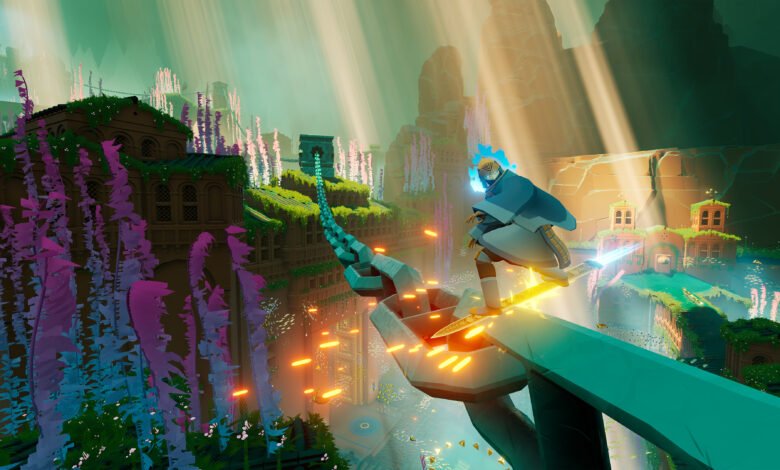Sword Of The Sea Review: A Dreamlike Adventure You Won’t Forget

▼ Summary
– Sword of the Sea is a new game by Giant Squid that blends extreme sports with environmental themes across eight vibrant levels.
– The player controls the Wraith, a silent character who rides a Hoversword to restore life to a damaged world through puzzles and exploration.
– The game emphasizes fluid movement and a meditative state, inspired by snowboarding, surfing, and skateboarding.
– It features stunning, diverse environments and allows interaction with marine life, though gameplay can become repetitive.
– Developed by Matt Nava, it continues the artistic and atmospheric style seen in his previous titles like Journey and Abzû.
Sword of the Sea elevates the artistic legacy of titles like Journey, Abzû, and The Pathless into a breathtaking new dimension. Players glide through eight visually stunning levels, each teeming with life and mystery, as they work to restore vitality to a world on the brink. This majestic adventure blends fluid movement and environmental storytelling with a poignant reflection on ecological fragility, all wrapped in a package that feels both exhilarating and meditative.
The creative force behind this experience, Matt Nava, has built a reputation for crafting worlds that feel both immense and intimate. As art director on the seminal Journey and founder of Giant Squid, Nava continues to explore themes of nature, solitude, and human connection. His latest work draws surprising inspiration from the kinetic thrill of extreme sports, snowboarding, surfing, and skateboarding, transforming these real-world sensations into a surreal, otherworldly journey.
You step into the role of the Wraith, a silent spectral figure who rides a luminous Hoversword across sweeping dunes, submerged ruins, and frozen wastes. There’s no traditional dialogue; emotion and narrative are conveyed through motion, light, and the haunting beauty of the surroundings. The goal is simple yet profound: revive barren landscapes by solving environmental puzzles and guiding life-giving waters through each region.
What truly sets Sword of the Sea apart is its masterful execution of flow. The game captures that rare, hypnotic state where movement and awareness merge into one seamless experience. Racing across sun-bleached deserts or weaving through bioluminescent underwater caves feels intuitive and deeply satisfying. The controls are responsive and expressive, allowing for tricks, drifts, and aerial maneuvers that never grow old.
Throughout the adventure, you encounter majestic marine creatures, whales, rays, and ancient reptiles, that serve not only as awe-inspiring set pieces but also as interactive elements of the world. Riding these beings offers new perspectives and pathways, emphasizing the game’s core theme of harmony between the explorer and the environment.
Visually, the game is a triumph. Each biome is rendered with a painterly vibrance that feels both fantastical and grounded. From the vivid orange skies of desert ruins to the deep blues of submerged temples, every frame could be a work of art. Austin Wintory’s score, wise and atmospheric, elevates the experience further, wrapping the player in a soundscape that is by turns contemplative and soaring.
That said, the experience isn’t without its repetitions. Some puzzles and objectives recur a bit too often, and the late-game shift toward a more conventional boss encounter feels at odds with the subtle, exploratory tone that defines much of the journey. Yet these are minor quibbles in a game that so consistently dazzles with its creativity and heart.
Sword of the Sea is a rare gem, a game that values wonder over warfare and introspection over instruction. It invites players to lose themselves in its beauty, to glide and dream and remember what it feels like to be small in a vast, mysterious world. For those willing to embrace its pace and poetry, it offers an adventure that lingers long after the screen goes dark.
(Source: TechRadar)